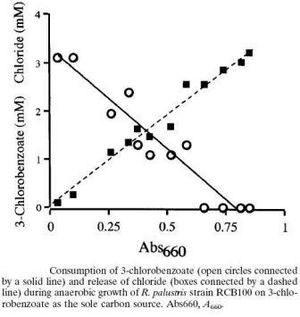Sphingomonas sp., agents: Difference between revisions
| Line 5: | Line 5: | ||
==Characterization of <i>Sphingomonas</i>== | ==Characterization of <i>Sphingomonas</i>== | ||
The Genus <i>Sphingomonas</i> includes many bacteria with varied morphological traits, so in 2001 they were separated into four distinct clusters under the Genus. These clusters are known as Sphingomonas, Sphingobium, Novosphingobium, and Sphingopyxis. There are about 20 known species that are distributed amongst these strains according to their chemotaxonomic and phenotypic traits. (http://ijs.sgmjournals.org/cgi/content/abstract/51/4/1405) | The Genus <i>Sphingomonas</i> includes many bacteria with varied morphological traits, so in 2001 they were separated into four distinct clusters under the Genus. These clusters are known as Sphingomonas, Sphingobium, Novosphingobium, and Sphingopyxis. There are about 20 known species that are distributed amongst these strains according to their chemotaxonomic and phenotypic traits. (http://ijs.sgmjournals.org/cgi/content/abstract/51/4/1405) | ||
Some shared traits among all strains of Sphingomonas are that they are Gram-negative and possess a bacillus (rod) shape. The bacteria are also strictly aerobic chemoheterophs. Whereas other bacteria utilize lipopolysaccharides in their cell envelopes, Sphingomonas integrate glycosphingolipids. Additionally, in cultures Sphingomonas colonies typically appear yellow. | |||
(http://www.springerlink.com/content/v3654176x2651434/) | |||
==Soil contamination== | ==Soil contamination== | ||
Revision as of 23:34, 24 April 2011
Introduction
The Genus Sphingomonas includes a range of bacterium that are remarkable for their ability to break down polycyclic hydrocarbons. Bacteria in this genus have been detected in a variety of environments, both marine and terrestrial. In recent years, these bacteria have been a focus of study because of their possible applications for bioremediation (one of the major components of oil being stable aromatic hydrocarbons). [CITATION]
Characterization of Sphingomonas
The Genus Sphingomonas includes many bacteria with varied morphological traits, so in 2001 they were separated into four distinct clusters under the Genus. These clusters are known as Sphingomonas, Sphingobium, Novosphingobium, and Sphingopyxis. There are about 20 known species that are distributed amongst these strains according to their chemotaxonomic and phenotypic traits. (http://ijs.sgmjournals.org/cgi/content/abstract/51/4/1405) Some shared traits among all strains of Sphingomonas are that they are Gram-negative and possess a bacillus (rod) shape. The bacteria are also strictly aerobic chemoheterophs. Whereas other bacteria utilize lipopolysaccharides in their cell envelopes, Sphingomonas integrate glycosphingolipids. Additionally, in cultures Sphingomonas colonies typically appear yellow. (http://www.springerlink.com/content/v3654176x2651434/)
Soil contamination
.;l
Degradation of Aromatic compounds
lkjk;
Hydrogen Production
kjhklkj
Nanoparticle synthesis
khjkh
Conclusion
R.palustris is truly a versatile bacterium and its different metabolic capabilities have very important applications in this present day and age with problems of environmental contamination and non-renewable energy sources. It provides us a way for dealing with these problems by just optimizing some of these metabolic capabilites. It has a lot of potential in bio-remediation, hydrogen fuel production and nanoparticle synthesis and thus more research in these areas would of immense value.
References
Edited by student of Joan Slonczewski for BIOL 238 Microbiology, 2010, Kenyon College.


